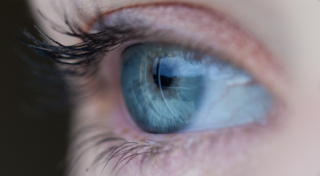"A Cast for the Eye after Retinal Surgery," by Yasser Elshatory, MD, PhD
Much like a cast immobilizes a limb and helps it heal, during retinal surgery, your surgeon may use an analogous immobilization/healing aid. Surgery on the retina that requires removal of the vitreous gel (called a vitrectomy) sometimes requires placing a vitreous substitute that exerts a force on the retina to flatten the retina. While the vitreous can be replaced with saline in cases where no such force is necessary, many retinal conditions such as retinal detachments and macular holes, require placing a gas mixture or oil in the eye. This gas or oil makes the vision blurry, because light does not pass through the gas and oil the same way it does through vitreous gel or saline. A retina specialist has special lenses that aid in focusing an image of their patient’s retina (on the specialist’s retina!) to assess the retina’s appearance and positioning. Much like a cast for a broken bone prevents one from using a limb, these vitreous substitutes also limit function of the eye. It does not hurt the eye to try to use it during this period. In fact, it is a good idea to keep the eye uncovered, to monitor the vision and ensure the vision is not worsening in any way. Worsening of vision during the post-operative period can suggest bleeding, recurrent detachment, or infection. So, it is important for patients to recognize their role in self-monitoring after a retina surgery, even with the limited vision they possess during this early phase after surgery. Positioning one’s head in different positions exerts a force on correspondingly different parts of the retina. Positioning one’s head with their face down, helps the gas mixture or oil in the eye press against the macula, the central part of the retina responsible for central vision. Sometimes, a detachment in the retina may involve a part of the retina that would be aided by positioning on one’s side, such that the vitreous substitute presses against the area that was detached prior to surgery. The substitute buys time for a laser or cryo scar to develop at the area that caused the detachment (often a tear or hole in the retina). Once a treatment scar develops, the chance of the retina detaching again decreases significantly. This usually takes about a week. If gas is placed in the eye, one should avoid going to high altitudes abruptly, such as in an airplane, or driving to high altitude without frequent enough stops. Gas mixtures placed in the eye expand under the lower atmospheric pressures, causing a sharp spike in eye pressure that can lead to blindness. Also, if a gas mixture is placed in the eye, one cannot undergo anesthesia that requires gas until the gas mixture dissolves from the eye. This usually happens 1-2 months after retinal surgery. If not, the gas anesthetic can travel to the eye, and cause an eye pressure spike, which can lead to blindness.

Comments
Post a Comment